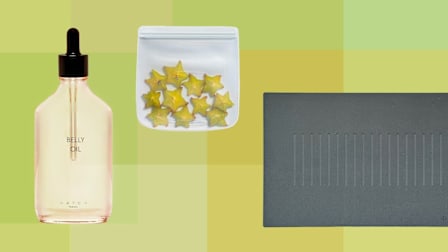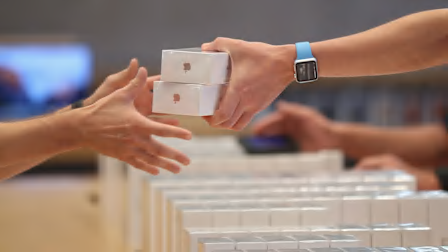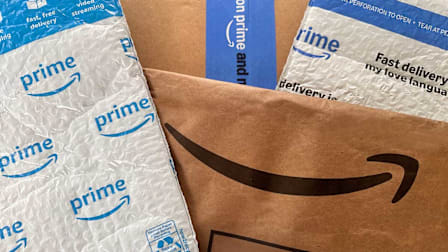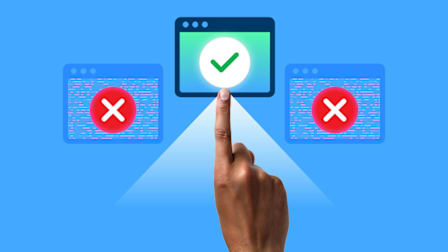Take Control of Tech Clutter
Get rid of old electronics, make space on your phone and computer, manage your passwords and email inbox, and more
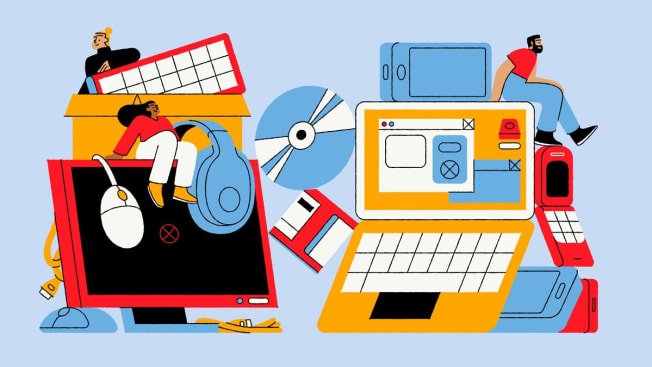
Here’s what to do with the old laptops, cell phones, and power cords you no longer need. Plus, how to organize what you do use, including streamlining that overflowing email inbox.
Get Rid of Old Electronics
Follow this step-by-step guide to saving what you need, deleting the rest, and recycling the hardware.
Gather and Sort Gadgets
The first step in taking control of unwanted devices is to collect them in one spot that’s convenient but out of sight, where you can work on the project gradually.
Then divide them into two categories.
Devices that don’t contain personal data on them, such as keyboards, headphones, and monitors, can go into boxes ready to sell, donate, or recycle.
The second group is for items that may have important files, such as laptops, phones, and CDs. In most cases, you’ll want to copy and then erase those files. (Instructions follow.) But if you don’t care about retrieving the information and just want to make sure sensitive data is deleted, you can try a free service that will take the items off your hands and erase the data—in which case, jump to "Sell, Donate, or Recycle," below.
What to do with that tangle of cords? Some can still be useful, even if you no longer want the gadgets they came with. For instance, if you're an iPhone user, you really can't have too many Lightning cables for charging your phone.
But other kinds of connectors are obsolete. This chart will help you decide. One note: Even if they're destined for the recycling pile, temporarily hang on to cables you might need to retrieve data from old laptops and other devices.
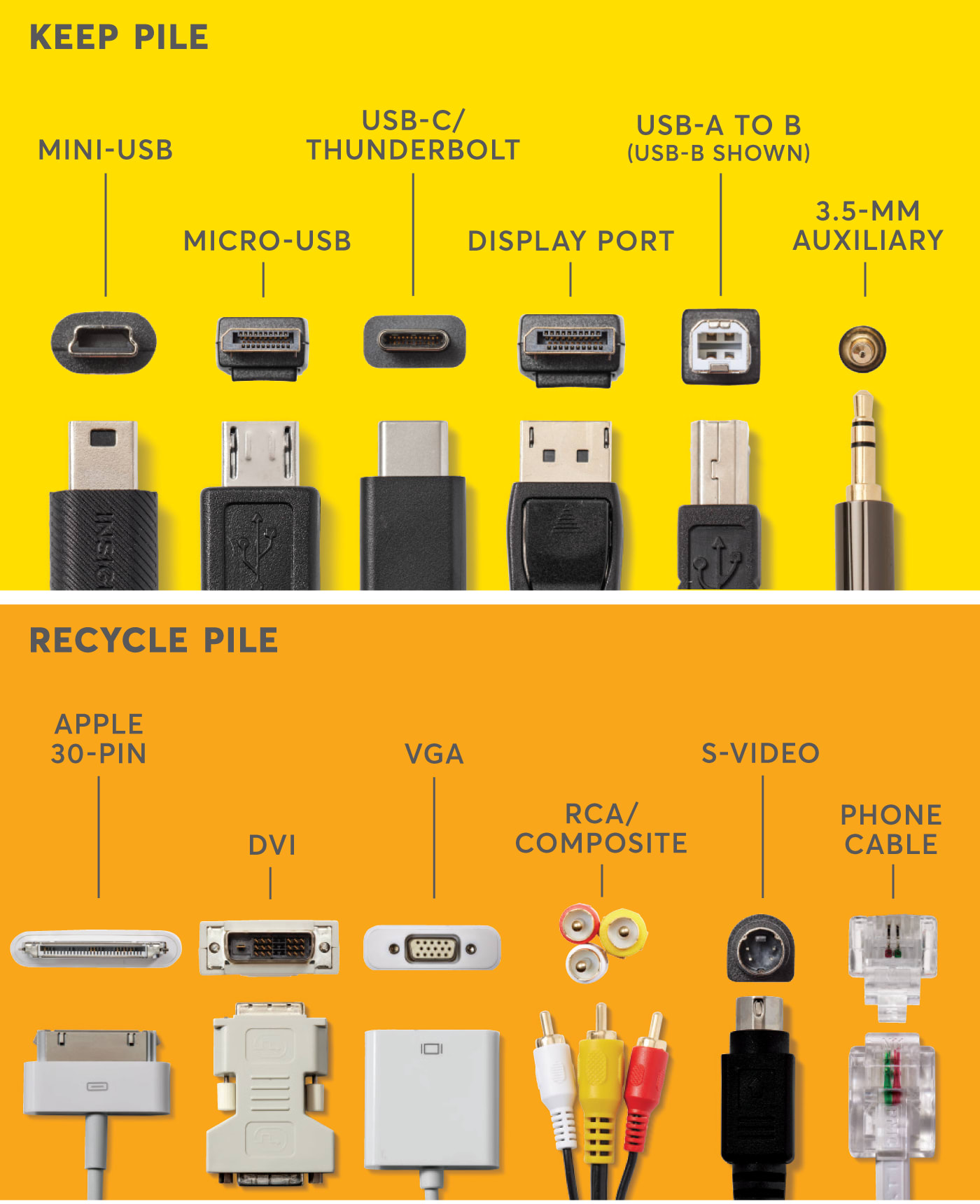

Make More Space on Your Devices
Eventually, your phone and laptop may start telling you they’re running out of space, especially if you’ve saved lots of photos and videos. Here’s how to declutter your devices.
Free Up Storage on Your Computer
Delete unused applications. The first step is to delete old applications, which can take up a lot of room on a hard drive. You might not even be using the biggest space hogs.
• Mac: Open Finder and go to the Applications folder. Select the app, then either drag it to the Trash or right-click it (or click while holding down the Control button) and choose File > Move to Trash. Then right-click on the Trash icon and choose Empty Trash.
• Windows: Go to Settings. Then choose Apps > Apps & features. Find the app you want to remove, then select More > Uninstall.
Delete duplicates. Identical copies of files aren’t just a waste of space; they’re confusing when you don’t know which file to open. Here’s an easy way to find and delete those duplicates.
• Mac: Open Finder and search for "(1)" with quotation marks.
• Windows: In File Explorer on Windows, search for filename: "*(1)*".
Use built-in utilities. These tools will recommend other ways to save space.
• Mac: Click the Apple icon, then System Settings > General > Storage.
• Windows: Find the app called Disk Cleanup, or a feature called Storage Sense under Start > Settings > System > Storage.
Declutter Your Desktop and Downloads Folder
Having numerous files on your desktop is like having papers spread all over your actual desk: It can be hard to find what you need and stressful to look at. Your downloads folder can get just as messy.
Delete the files on your desktop you no longer need, such as that PDF ticket for an event long ago, as well as unneeded shortcuts to applications.
Next, move files you do want to keep to the appropriate subfolder under your main Documents folder—or create a new subfolder if necessary.
Now open your Downloads folder and scroll through the list to identify any files you want to keep, such as downloaded bank statements. Move them to the appropriate folders under Documents.
Everything else, including installation files (.dmg on Mac, .exe on Windows), can be trashed.
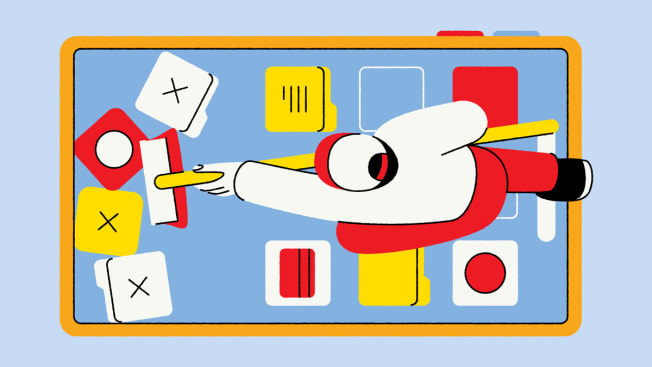
Illustration: Joseph Carrington Illustration: Joseph Carrington
Free Up Storage on Your Phone
Quickly clean up an Android phone. You can delete unused apps, duplicate photos, junk files, and more with the Files by Google app. Download it from the Play Store if it’s not already installed. In the app, tap Clean on the bottom. Then you can choose the kinds of files and apps you want to remove with just a few taps.
Delete unused apps on an iPhone. Go to Settings > General > iPhone Storage to see a color-coded bar graph showing your storage usage. Below that, click on the recommendations iOS will present to you, such as enabling "Offload Unused Apps," which deletes the apps but keeps the user data in case you want to use the apps in the future. You’ll also see on this screen the apps that are installed on your phone and their size. Tap on the ones you wish to delete.
Optimize photos and videos. Photos and videos tend to take up the most storage space. Photo optimization stores full-resolution versions in the cloud while leaving smaller versions on your phone.
• On an Android phone: Go to Google Photos’ settings and select "Free up space."
• On an iPhone: Go to Settings > Photos and enable "Optimize iPhone Storage." Now you’ll have more room...for more photos and videos.
Tidy Your Digital Accounts
Online life brings certain headaches, such as ever-changing passwords and an overflowing inbox. Here are fixes for those annoyances.
Manage Your Passwords
Have you clicked a "Forgot password?" link in the past few months? Resetting your password because you can’t remember it is no one’s idea of a good time. For your security, and to make logging in to accounts as hassle-free as possible, we recommend using a password manager, which generates and saves long, unique passwords for all your online accounts. (One thing you should never do is reuse the same password on multiple sites, which is a major security risk.) In CR’s tests, 1Password (from $36 per year) performed the best for its balance of privacy, security, and ease of use. Dashlane and Keeper offer both free and paid options.
Once you start using a password manager, you need to remember just one password—the one you use to access all your stored log-in credentials. Make it long (at least 16 characters), unique, and memorable. You can use a series of random words separated by hyphens or spaces. It’s fine to write this down in a notebook stored safely at home.
Shut Down Old Accounts
Many of us have long-forgotten accounts with retailers, apps, media sites, and more. This raises the odds of your data being misused or stolen. To find old accounts to close, search for emails with phrases like "welcome to" and "confirm your email." To avoid phishing attacks, don’t click on links in these emails. Instead, go to the company website in a fresh browser tab.
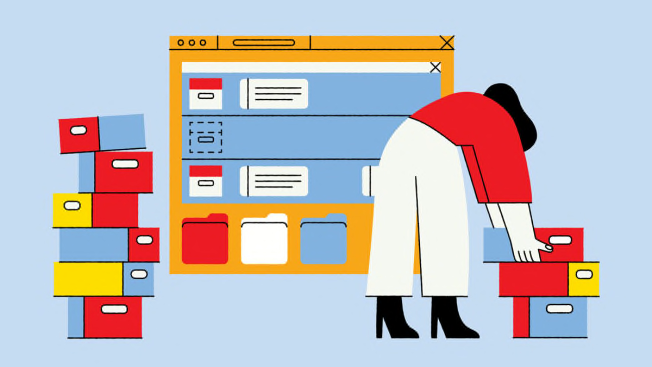
Illustration: Joseph Carrington Illustration: Joseph Carrington
Empty Your Email Inbox
An inbox full of hundreds if not thousands of read and unread emails is distracting and can be a source of stress. You could archive everything, but the emails will take up space and it could cost money if you exceed the account’s free storage limit. See how to delete emails en masse, even hundreds at a time.
Stop Unwanted Emails
Once you empty your inbox of marketing emails, you don’t want it to quickly fill back up.
Marketers give you a way to stop receiving their messages. A convenient tactic for collecting a lot of them in one place is to search your inbox for common marketing lingo like "today only," "while supplies last," "limited time," "coupon," and even "privacy policy" and "edit your preferences."
Then, in the search results, open each email and click on the Unsubscribe link next to the email sender’s name, if it’s available. Or scroll to the bottom of the email to find the Unsubscribe link to remove yourself from the mailing list.
Repeat with each sender, and enjoy deleting the emails as you go.
Editor’s Note: This article also appeared in the July 2023 issue of Consumer Reports magazine.

















